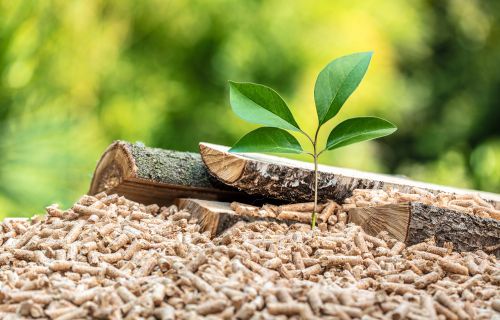Briquettes - universal fuel

At a time of growing environmental awareness, more and more people are consciously abandoning the use of fossil fuels in their households. However, this does not have to mean any kind of sacrifice. For there are many environmentally friendly alternatives to coal or gas. One such material is efficient and easy to produce briquette - that is, compressed fuel in the form of blocks, produced from biomass, i.e. waste of natural origin.
Let's take a closer look at it.
Types of briquettes
At the outset, it is worth noting that we distinguish several types of briquettes. The criterion for this division is primarily the material from which a particular variety is produced:
Wood briquettes
These briquettes are made from sawdust, shavings or other wood waste. They are relatively environmentally friendly, as they produce a small amount of smoke and ash. The calorific value of wood briquettes ranges from 18 to 22 MJ/kg, making them ideal for home stoves, fireplaces and biomass stoves.
Biomass briquettes
Produced from a variety of vegetable waste, such as sunflower hulls, straw and olive pomace. The calorific value of these briquettes is usually 15-20 MJ/kg, and their main advantage is that they are made from raw materials intended for disposal. Burning biomass has less impact on the environment than using fossil fuels, for example, because the carbon dioxide emitted during combustion is offset by the CO2 that plants absorb during photosynthesis.
Briquettes from paper waste
A separate subcategory is briquettes made from paper waste and waste paper. Although less popular than the other varieties, they are used in some industrial furnaces and boilers. Their calorific value is lower than that of biomass or wood. Nevertheless, they are an eco-friendly alternative that helps reduce waste.
Also check out our other article: Briquettes vs coal - which fuel to choose
Briquette production process
The production of briquettes is a relatively straightforward process, but one that requires the right equipment in the form of a briquetting machine.
It can be summarized in a few simple steps:
Preparation of raw material
Raw materials used for briquette production, such as wood or biomass, must first be properly prepared. Often this includes their initial shredding (for this we will need a shredder or chipper) and then drying. The lower the moisture content of the raw material, the more efficient the combustion of the resulting briquettes will be.
Briquetting
After preparing the raw material, the material is fed into the briquetting machine. There the process of briquetting takes place, i.e. pressing the raw material under high pressure. As a result, the raw material obtains a compact, dense form. The powdery starting material is formed into compact blocks of sizes depending on the parameters of the briquetting machine.
Cooling and packaging
Finished briquettes are cooled and then, if intended for sale, packaged for easy transport and storage. Many briquettes are packaged in bags of a specific weight for easy distribution in the market.
An important advantage of briquette production is the ability to use waste that might otherwise end up in landfills. This also makes the briquette production process environmentally beneficial, as it allows materials that might otherwise be considered waste to be reused.
Combustion parameters of briquettes
The combustion efficiency of briquettes depends on their caloricity, moisture content and density. High caloricity means a greater amount of energy obtained from a unit mass of fuel. Briquettes, due to their density and low moisture content (compared to bulk wood, for example), burn efficiently and generate a large amount of heat.
Approximate heating values for various briquettes are as follows:
-
Wood briquettes: 18-22 MJ/kg
-
Biomass briquettes: 15-20 MJ/kg
-
Recycled paper briquettes: 14-18 MJ/kg
Application of briquettes
Briquettes are widely used both in households and in industry. They can be successfully used to fuel domestic boilers and generate heat for domestic use. Unlike pellets, briquettes require less specialized heating equipment. Briquettes can even be burned in a fireplace or so-called "goat".
Briquettes will also work well in industry. Their combustion can generate heat and energy for production halls and all kinds of plants. An interesting example of such an application could be all kinds of paper mills. In such a situation, briquettes created from paper scraps can be used as fuel to generate electricity, steam or heat necessary for further paper production.
Summary
Briquettes are a versatile, efficient and environmentally friendly fuel that is widely used in domestic heating systems, industry and power generation. Thanks to the variety of types of briquettes, they can be tailored to meet the different needs of users. Their production process is relatively simple, and their combustion is efficient and more environmentally friendly than traditional fossil fuels. Briquettes also do not require extensive equipment facilities in the form of specialized boilers or burners (as is the case with pellets, for example ).
Their greatest advantage, however, seems to be that any farm generating significant amounts of bio-waste can, with a relatively small contribution, undertake the production of this fuel on its own and thus become independent of external suppliers.






